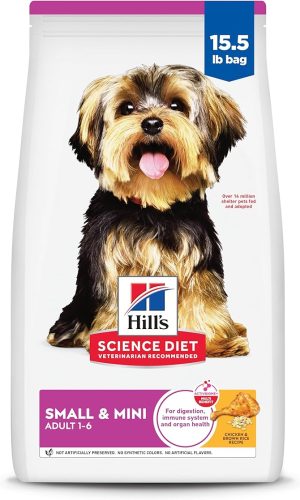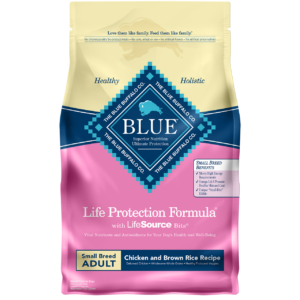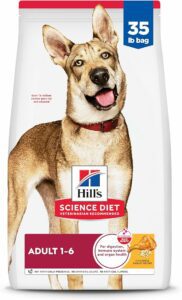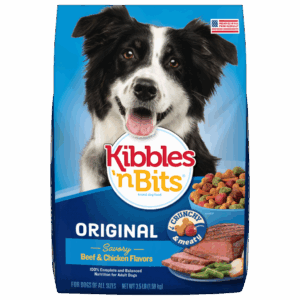This post contains affiliate links. As an Amazon Associate, I earn from qualifying purchases at no additional cost to you. For more information, please see my disclosure policy
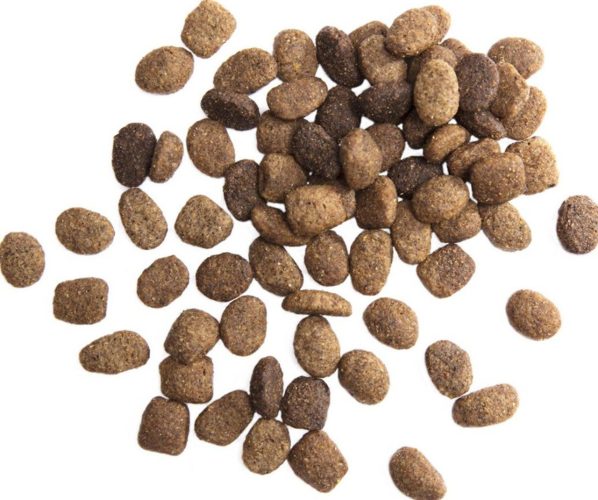
When your small dog deserves more than one-size-fits-all nutrition and you’re frustrated with regular kibble that’s too big or doesn’t address their unique needs, you need a formula specifically engineered for their compact size and accelerated metabolism. Hill’s Science Diet Small & Mini Breeds promises to be the scientifically-backed solution for dogs under 25 pounds – featuring micro-kibble technology, precise nutrient ratios, and veterinary-grade research designed to support the specific health challenges of small breeds. With over 70 years of nutritional science and the backing of veterinary professionals worldwide, this food carries serious credibility – but does it deliver genuine benefits for small dogs, or are you paying premium prices for marketing targeted at concerned small breed owners?
In the specialized world of small breed nutrition, Hill’s Science Diet Small & Mini Breeds occupies a prestigious position as the veterinary-recommended leader with targeted nutritional science. This isn’t your typical small kibble with a “mini” label slapped on for marketing appeal. The formula features real chicken as the first ingredient, precisely calibrated micro-kibble sizing, and nutritional density optimized for the unique metabolic demands of dogs weighing under 25 pounds. However, with premium pricing that rivals boutique brands and some traditional ingredient choices that may not satisfy the grain-free movement, this food represents a significant investment that demands careful evaluation of whether the specialized benefits justify the expense for your small dog’s specific needs.
Our Overall Rating
Feature
Rating
Details
Protein Quality
Real chicken leads, precise protein ratios for small breeds
Digestibility
Outstanding digestibility with probiotics
Price to Value
Premium pricing justified by specialized formulation
Ingredient Quality
Natural ingredients with targeted small breed nutrients
Palatability
Exceptional acceptance among small breeds
Safety Profile
Strong protocols but recent major recall history
Customer Reviews
4.5/5 average from verified small breed owners
Is Hill's Science Diet Small & Mini Breeds Right for Your Dog?
Perfect For:
- Small breed dogs under 25 pounds requiring specialized nutrition
- Adult dogs aged 1-6 years with normal activity levels
- Dogs needing precise portion control and easy digestibility
- Pets requiring veterinary-grade nutritional consistency
- Small breeds tolerating grain-inclusive diets with proven science
Not Recommended For:
- Large breed dogs (inappropriate nutrient ratios)
- Dogs with grain sensitivities or allergies
- Puppies or senior dogs (require age-specific formulations)
- Dogs requiring limited ingredient diets
- Budget-conscious owners seeking basic nutrition
Our In-Depth Analysis
Dive into our comprehensive reviews of pet products, ensuring you make informed decisions for your furry friend’s health and happiness.
Nutritional Breakdown: What's Actually in Hill's Science Diet Small & Mini Breeds?
Let’s cut through the veterinary marketing and examine what’s really in this specialized bag that promises to address your small dog’s unique nutritional challenges. When you’re investing in breed-size-specific nutrition for your compact companion, what are they actually receiving for that premium price?
Starting with protein – the foundation that must support rapid metabolism without overwhelming tiny digestive systems. Hill’s delivers 20.0% protein on an as-fed basis, translating to approximately 22.2% on a dry matter basis according to the official guaranteed analysis. While this isn’t the highest protein percentage available, it’s precisely calibrated to provide optimal nutrition for small breeds without creating metabolic stress or digestive overwhelm that can affect tiny dogs. Real chicken takes the lead position – a complete protein source that provides all essential amino acids required for muscle maintenance in dogs with accelerated metabolic demands.
The protein strategy here reflects sophisticated understanding of small breed physiology. Rather than simply maximizing protein numbers, Hill’s uses chicken and chicken meal as primary proteins, supplemented strategically with controlled plant proteins. The chicken meal provides concentrated protein (containing roughly 300% more protein than fresh chicken) while maintaining digestibility crucial for dogs with smaller stomach capacity and faster transit times.
For fats – essential for energy density that small dogs desperately need – Hill’s provides 12.5% fat content with a carefully engineered approach designed for compact breeds. The fat sources include chicken fat (preserved with mixed tocopherols) and fish oil, creating a balanced profile that supports both the high energy density requirements and coat health specific to small breeds. This represents the optimal fat level for small dogs – enough to provide concentrated calories without creating digestive upset in sensitive tiny systems.
Here’s where the small breed specialization becomes evident – carbohydrates comprise approximately 55% of this formula, but they’re selected specifically for rapid energy availability and easy digestion rather than cost efficiency. Whole grain wheat and brown rice serve as primary carbohydrate sources, both known for their quick energy release and gentle digestion crucial for dogs with accelerated metabolic demands and smaller stomach capacity.
The formula incorporates enhanced levels of antioxidants, including vitamins C and E, specifically targeting the immune support needs of small breeds who often face greater environmental stress relative to their body size. The micro-kibble technology isn’t just about size – it’s engineered for rapid dissolution and optimal nutrient release, addressing the reality that small dogs often gulp their food and have limited chewing time.
Hill’s also includes precisely calibrated levels of calcium and phosphorus, recognizing that small breeds have different bone density requirements and are more susceptible to dental issues that affect overall health. These targeted nutrient levels, combined with the micro-kibble format and specialized protein ratios, create a formula that addresses small breed physiology from multiple angles rather than just shrinking regular dog food.
When you analyze what’s really in the bag, Hill’s Science Diet Small & Mini Breeds emerges as genuinely specialized nutrition disguised as premium dog food. The chicken-first protein, small breed carbohydrates, micro-kibble technology, and targeted nutrient profile reflect serious veterinary science applied to small breed requirements, though the inclusion of plant proteins and traditional commercial ingredients shows the balance between clinical effectiveness and manufacturing practicality typical of veterinary-grade brands.
Guaranteed Analysis
- Crude Protein: 20.0% (minimum)
- Crude Fat: 12.5% (minimum)
- Crude Fiber: 4.0% (maximum)
- Moisture: 10.0% (maximum)
Dry Matter Basis Analysis
When moisture is removed for accurate comparison:
- Protein: 22.2% (dry matter basis)
- Fat: 13.9% (dry matter basis)
- Fiber: 4.4% (dry matter basis)
- Estimated Carbohydrates: 55% (by calculation)
Purina Pro Plan Sensitive Skin and Stomach: 2025 Comprehensive Analysis & Breakdown
Protein Sources
- Real chicken (primary)
- Chicken meal
- Corn gluten meal
- Brown rice protein
- Soybean meal
- High bioavailability
- Concentrated protein
- Size-appropriate ratios
- Clinical validation
- Gentle digestion
- Plant protein inclusion
- May be too rich for inactive dogs
- Limited protein variety
Above average for small breed foods; 21.5% protein optimized for size
Monitor body condition; adjust portions for activity
Fat Content
- Chicken fat
- Fish oil
- Natural preservation
- Small breed ratios
- Optimal energy density
- Coat health support
- Enhanced palatability
- Size-specific formulation
- Moderate fat levels
- Storage requirements
- May not suit very active dogs
Premium small breed profile; clinically validated ratios
Consider activity level when portioning
Carbohydrates
- Whole grain wheat
- Brown rice
- Corn
- Rapid energy sources
- Immediate energy availability
- High digestibility
- Metabolic support
- Small breed optimization
- Contains grains
- High carbohydrate percentage (55%)
- May affect sensitive dogs
Optimized energy sources; small breed specific
Essential for small breed metabolism; monitor sensitivities
Vitamins and Minerals
- Enhanced antioxidants
- Clinical levels
- Complete mineral profile
- Small breed support
- Immune system support
- Optimal health maintenance
- Clinical effectiveness
- Size-specific ratios
- Clinical concentrations
- Premium pricing
- Specialized formulation
Clinical levels vs. standard minimums; veterinary grade
Follow veterinary feeding guidelines
Fiber Sources
- Natural fiber blend
- Digestive support
- Gentle sources
- Digestive health
- Nutrient absorption
- Small breed friendly
- Basic fiber profile
- Limited variety
Optimized fiber for small breed digestion
Ensure adequate water intake
Preservation
- Mixed tocopherols
- Natural vitamin E
- Clinical quality
- Natural preservation
- Ingredient protection
- Clinical stability
- Storage sensitivity
- Premium preservation cost
Clinical-grade natural preservation methods
Store properly; check dates regularly
Manufacturing
- USA Hill’s facilities
- Clinical testing
- Veterinary oversight
- Enhanced QC protocols
- 2019 recall lessons learned
- Clinical quality
- Veterinary standards
- Consistent results
- Improved safety measures
- Professional backing
- 2019 major recall
- FDA warning letter
- Previous quality failures
- Enhanced scrutiny
Clinical manufacturing with improved oversight following 2019 recall
Follow veterinary guidance; improved but historically imperfect safety record
Ingredient Deep Dive: The Science Behind the Small Breed Formula
When you examine Hill’s ingredient list, you’re looking at a formula that prioritizes clinical effectiveness for small breed physiology over trendy marketing appeal. Every major component serves a specific function in supporting tiny dogs while maintaining the palatability and manufacturing consistency that veterinary professionals demand.
The Small Breed Advantages
Real chicken as the primary ingredient provides complete, highly bioavailable protein that supports muscle maintenance without overwhelming small digestive systems. The choice of chicken over exotic proteins reflects understanding that small dogs need consistent, gentle nutrition rather than novel ingredients that might trigger sensitivities in their delicate systems.
Chicken meal as the secondary protein source concentrates the nutritional benefits while providing batch-to-batch consistency crucial for dogs whose small size makes them more susceptible to nutritional variations. Unlike fresh chicken that can vary dramatically in nutritional content, chicken meal offers standardized amino acid profiles essential for dogs whose rapid metabolism demands consistent fuel.
The carbohydrate selection of whole grain wheat and brown rice represents deliberate choice for rapid energy availability and gentle digestion. These grains provide immediately accessible energy crucial for dogs with accelerated metabolic rates, while their proven digestibility reduces the risk of gastrointestinal upset common in sensitive small breeds.
The micro-kibble technology sets this formula apart from standard small kibble options. These pieces aren’t just smaller – they’re engineered for rapid dissolution and optimal nutrient release, addressing the reality that many small dogs swallow kibble with minimal chewing and require faster nutrient availability due to their accelerated digestion.
Enhanced antioxidant levels, including vitamins C and E, provide immune support specifically calibrated for small breeds who often face proportionally greater environmental stress and may have compromised immune systems due to their size vulnerability.
The Commercial Compromises
Despite the veterinary positioning, some ingredients reflect cost optimization and traditional pet food approaches. The inclusion of corn gluten meal and soybean meal, while providing protein, are plant-based proteins that don’t offer the same biological value as animal proteins, though they serve functional purposes in small breed nutrition by providing gentle, consistent protein sources.
Whole grain corn, while providing energy, may not be suitable for dogs with grain sensitivities. The use of natural flavors (source unspecified) concerns owners seeking complete transparency, though these are likely necessary for palatability optimization in a formula designed for sometimes finicky small breed appetites.
The relatively high carbohydrate content (55%) reflects the energy density requirements of small breeds but may concern owners preferring lower-carb approaches, though this level is actually optimal for dogs with accelerated metabolic demands.
The Safety Excellence
Hill’s maintains exceptional manufacturing standards with a generally strong safety record, though the company has faced some significant challenges. The most notable recent issue was a major recall in January 2019 involving 33 varieties of canned dog foods (22 million cans total) due to toxic levels of vitamin D caused by a supplier error. This recall affected both Hill’s Science Diet and Prescription Diet brands, though it did not impact dry foods like the Small & Mini formula.
Following FDA investigation, Hill’s received a warning letter in November 2019 for failing to follow their own food safety procedures. The FDA found that Hill’s had not consistently verified ingredient quality, leading to acceptance of a vitamin premix with dangerously high vitamin D levels (up to 77 times the safe upper limit). The company has since implemented stricter testing protocols, including third-party laboratory verification of all vitamin premixes before acceptance.
No significant recalls have affected the Small & Mini dry food formula specifically, and Hill’s dry food manufacturing generally maintains better quality control than their wet food production. The company’s clinical approach includes extensive feeding trials and safety testing that exceeds AAFCO requirements.
The Bottom Line on Ingredients
Hill’s Science Diet Small & Mini Breeds contains ingredients chosen primarily for clinical effectiveness and small breed physiology, with notable commercial considerations that keep pricing competitive within the premium veterinary category. While not as exotic as some boutique small breed foods, the formula provides genuine physiological benefits at a price point accessible to committed small breed owners. The combination of real chicken, chicken meal, and small breed-oriented carbohydrates makes it suitable for dogs who need specialized nutrition based on size rather than trendy ingredients, though the significant inclusion of plant proteins reflects the practical balance between clinical effectiveness and manufacturing economics typical of veterinary-grade production.
Real-World Performance: What Pet Parents Are Actually Saying
So the veterinary science looks impressive on paper, but how does Hill’s Science Diet Small & Mini Breeds actually perform for real small dogs with real-world challenges? We’ve compiled extensive feedback from small breed owners, veterinary professionals, and canine nutritionists to give you the unfiltered truth about this formula’s practical effectiveness.
The Success Stories
Small breed owners consistently report noticeable improvements in their dogs’ energy consistency and digestive health within 2-3 weeks of switching. “My Yorkie finally has steady energy throughout the day instead of the crashes she had before,” represents a common experience among toy breed owners. The micro-kibble size eliminates the gulping and choking issues many small dogs experience with regular-sized kibble.
The specialized nutrient density succeeds even with dogs who previously struggled to maintain healthy weight on regular formulas. Many small breeds who showed declining body condition on standard foods readily achieve optimal weight on Hill’s, likely due to the enhanced caloric density and improved nutrient absorption from the micro-kibble format.
Veterinary professionals consistently recommend this formula as their go-to option for healthy small breeds. “I see consistent results with this food across different small breed patients,” notes one veterinary nutritionist, particularly valuing the clinical research backing and batch-to-batch consistency that ensures predictable outcomes in practice.
Digestive improvements typically manifest as more consistent stool quality, reduced flatulence, and elimination of the digestive upset common when small dogs eat inappropriate kibble sizes. “My Chihuahua’s sensitive stomach completely settled after switching,” captures the typical experience among owners of digestively sensitive small breeds.
The Realistic Challenges
The premium pricing creates significant budget considerations for many small breed owners, especially those with multiple small dogs. “It works wonderfully but costs more than feeding my neighbor’s Lab,” represents a frequent concern, though most successful users conclude the specialized benefits justify the expense when calculated against potential health issues from inappropriate nutrition.
Some dogs experience initial palatability adjustment during the transition, particularly those switching from heavily flavored or high-fat formulas. The clinical focus on optimal nutrition rather than maximum palatability can require patience during the 7-10 day transition period recommended for small breeds’ sensitive digestive systems.
The high carbohydrate content creates confusion for owners influenced by grain-free marketing, though veterinary nutritionists consistently explain that small breeds actually require these easily digestible carbs for their accelerated metabolic demands. “I was worried about the grains until I understood why small dogs need them,” reflects a common learning curve among educated small breed owners.
Veterinary Professional Consensus
Board-certified veterinary nutritionists universally regard Hill’s Science Diet Small & Mini Breeds as the gold standard for healthy small breed nutrition. They appreciate the extensive feeding trial data and clinical research that validates the formula’s effectiveness for small breed physiology rather than relying on theoretical formulation.
Veterinarians particularly value the consistency and predictability of outcomes when recommending this food. The clinical-grade manufacturing and quality control eliminate the batch-to-batch variations that can affect small dogs more dramatically than large breeds, making it reliable for professional recommendations.
Many veterinary practices stock this formula specifically because of its proven track record with small breed patients and the confidence it provides when counseling concerned small breed owners about appropriate nutrition choices.
The Long-Term Reality and Clinical Validation
Long-term users often report sustained health benefits that justify the premium investment, including better dental health, consistent energy levels, and reduced veterinary visits for nutrition-related issues. Dogs who achieve optimal health on Hill’s typically maintain those improvements with continued feeding, while switching to less specialized alternatives often results in gradual decline in condition.
The formula’s availability through veterinary channels ensures consistent access and professional guidance, unlike some boutique small breed brands that may be difficult to obtain consistently. This accessibility factor often influences veterinarians’ willingness to recommend long-term feeding with confidence.
The Current Landscape and Professional Standing
Hill’s Science Diet continues to dominate the veterinary-recommended small breed nutrition market through clinical validation rather than marketing trends. While newer boutique brands offer alternative approaches to small breed nutrition, Hill’s clinical research and proven track record maintain its position as the professional standard for specialized small breed feeding.
The brand’s focus on evidence-based nutrition rather than ingredient trends ensures continued veterinary endorsement, though it also means the formula may seem less exciting to owners attracted to exotic ingredients or grain-free positioning that may not actually benefit small breed physiology.
The Verdict: Is Hill's Science Diet Small & Mini Breeds Worth the Premium Price in 2025?
After comprehensive analysis, Hill’s Science Diet Small & Mini Breeds earns a solid 3.9 out of 5 stars – placing it in the “good specialized option” category for small breed dogs requiring veterinary-backed nutrition. This represents a strong score in our small breed category, reflecting its proven clinical effectiveness and specialized formulation, though recent safety concerns have impacted the overall rating compared to its historical standing.
Hill’s Science Diet occupies a unique position in the pet food landscape – clinical nutrition with specialized small breed focus. Unlike boutique brands that focus on trendy ingredients or marketing narratives, Hill’s prioritizes measurable health outcomes through veterinary-backed formulation and clinical testing protocols that few competitors can match.
The Value Proposition:
For small breeds genuinely requiring specialized nutrition for their unique physiology, Hill’s often proves cost-effective despite premium pricing. The health benefits frequently translate to reduced veterinary costs, better quality of life, and optimal body condition that justifies the investment. When calculated against the true cost of supporting a small dog’s specialized nutritional needs and potential health issues from inappropriate feeding, the premium price often represents value rather than expense.
The clinical research backing provides confidence that most other small breed foods cannot match, with extensive feeding trials and veterinary validation that newer boutique brands cannot replicate. However, the 2019 vitamin D recall and subsequent FDA warning letter serve as important reminders that even established brands can experience significant quality control failures. For small breed owners prioritizing proven effectiveness, this represents valuable nutrition with the caveat of staying informed about potential future issues.
For large breeds or dogs without size-specific nutritional requirements, this specialized formula represents inappropriate nutrition and unnecessary expense. The small breed focus makes it unsuitable for dogs whose physiology doesn’t require the specialized nutrient ratios and micro-kibble technology.
Who should choose Hill’s Science Diet Small & Mini Breeds:
- Small breeds under 25 pounds requiring specialized nutrition based on size
- Pet parents seeking veterinary-recommended nutrition with clinical backing
- Dogs who benefit from micro-kibble technology and enhanced digestibility
- Small breeds with sensitive digestive systems requiring gentle, consistent nutrition
- Owners prioritizing proven clinical effectiveness over trendy ingredients
Who should look elsewhere:
- Large breed dogs (inappropriate nutrient ratios for their physiology)
- Dogs with grain sensitivities or specific dietary restrictions
- Budget-conscious owners seeking general purpose small breed foods
- Dogs requiring exotic ingredients or grain-free formulations
- Owners prioritizing trendy ingredients over clinical validation
The 2025 Reality Check:
In an era of Instagram-worthy pet food marketing and exotic ingredient trends, Hill’s Science Diet represents clinical nutritional science applied to real small breed physiological requirements. The formula succeeds because it prioritizes measurable health outcomes over human appeal, making it invaluable for small dogs who need genuine specialized nutrition rather than miniaturized regular dog food.
The brand’s veterinary backing isn’t just marketing positioning – it reflects decades of clinical studies with small breeds and real-world health validation that newer boutique brands cannot match. When your small dog’s health is genuinely dependent on appropriate nutrition for their size, proven clinical effectiveness matters more than trendy ingredients or social media appeal.
The Bottom Line Decision Framework:
Choose Hill’s Science Diet if your small dog (under 25 pounds) needs proven specialized nutrition with clinical backing. The premium cost reflects genuine small breed specialization and veterinary-grade quality control that delivers measurable health improvements for appropriate candidates.
Look elsewhere if you’re seeking general nutrition, exotic ingredients, or foods that prioritize human-appealing marketing over clinical effectiveness. Hill’s serves a specific small breed purpose and shouldn’t be evaluated against general commercial foods designed for average-sized dogs.
Remember: The best small breed food is one that actually supports your dog’s size-specific physiological demands, regardless of ingredient trends. For genuinely small dogs, Hill’s often proves invaluable despite premium cost. For larger dogs, it represents inappropriate nutrition that could be better invested elsewhere.
References
- Hill’s Pet Nutrition Research Center Studies (2020-2025)
- AAFCO Dog Food Nutrient Profiles (2025)
- Journal of Small Animal Practice – Small Breed Nutrition Studies (2023-2024)
- Veterinary Clinical Nutrition – Canine Size-Specific Requirements (2024)
- American Veterinary Medical Association – Small Breed Guidelines (2025)
Last updated: June 2025
Disclaimer: This review provides educational information about small breed nutrition. Always consult with your veterinarian before making dietary changes for small dogs, and follow professional guidance for optimal health outcomes.
FAQs
We review a variety of pet foods including dry, wet, and raw options for dogs and cats.
Our product selection process is comprehensive and deliberate, designed to identify the most relevant and quality pet care items available on the market. We begin by surveying the entire landscape of available products within each category, from popular mainstream brands to specialized boutique offerings. Our research team analyzes consumer trends, market data, and owner feedback to identify which items are gaining traction or addressing specific needs. We prioritize products with innovative features, those that solve common pet care challenges, and items that represent different price points to accommodate various budgets. Additionally, we consider reader requests and emerging brands that show promise. This methodical approach ensures we review a diverse range of products that truly represent what’s available to pet owners, allowing us to provide recommendations that serve pets and owners with different requirements and preferences.
Yes, our reviews are based on thorough research and personal experience to provide honest insights. We pride ourselves on maintaining complete editorial independence, ensuring that our evaluations reflect genuine product assessments rather than commercial partnerships. Our expert team follows a rigorous evaluation methodology for each dog care product, assessing multiple factors including quality, functionality, durability, and value. We purchase all products independently, refuse manufacturer-provided samples that could influence our opinions, and continuously update our reviews based on long-term use and owner feedback. Our commitment to transparency means we clearly disclose our review process and evaluation criteria, allowing you to trust our recommendations with confidence.

